Military Vehicle Glossary
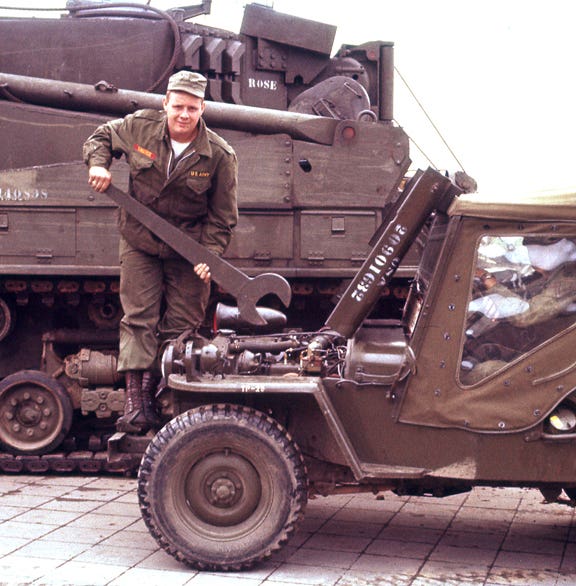
Steve Turchet shares some common acronyms, designations, slang terms, vehicle names and nicknames commonly used in the historic military vehicle hobby.
Keep in mind that this list is far from complete, and not everyone in the hobby uses the same designations or terms.
A
AFTERMARKET: Usually refers to parts or accessories made by a manufacturer other than the original builder of a vehicle.
AFKWX: G-number designation: G-508. Manufacturer designation: AFKWX. A three-axle, ten-wheel-drive 2 ½-ton cab-over-engine (COE) truck built by General Motors Corporation during WWII. Most are powered by a GMC 270 cid, 6-cyl OHV engine, have five-speed overdrive transmissions and two-speed transfer cases. Most are cargo trucks, though there are also several variants.
AIRFIELD LIGHTING VEHICLE: A vehicle equipped to provide supplemental or emergency lighting on air strips. Also used for night construction work. A common example is the Chevrolet J5 of WWII.
AMERICAN MOTORS (AMC): American Motors Company, formerly Nash-Kelvinator Corporation, formerly Nash Motors (manufacturer of Rambler automobiles). AMC purchased Kaiser Industries’ Jeep vehicle division in 1970.
AM GENERAL (AMERICAN MOTORS GENERAL): Once a division of AMC. A manufacturer of various civilian and military vehicles, including the HMMWV.
APC: Armored Personnel Carrier. Usually full-tracked vehicles, such as the M113. (See also FULL-TRACKED and M113) They may be armed, generally with heavy machine guns. though their primary purpose is to transport troops in combat areas. A common nickname is Battle Bus.
ARCTIC KIT: A military-issued accessory kit for various M-series vehicles, usually consisting of a personnel heater (sometimes an engine heater as well) and insulated engine compartment, cab, and cargo bed covers to adapt a vehicle for extreme cold weather operation.
ARCTIC HEATER: A military-issued, often fuel-fired (gasoline or diesel) heater fitted to M-series vehicles for extreme cold weather operation: however, some kits feature a heater that uses the vehicle’s engine coolant. Often part of an ARCTIC KIT. (See also PERSONNEL HEATER and ENGINE HEATER)
ARMORED CAR: Usually an armored wheeled vehicle, sometimes armed with various weapons. Examples are the White M3A1 Scout Car, the Ford M8 Greyhound, and the Cadillac Gage Commando.
B
BANTAM: Usually refers to the WWII “Jeep” prototype manufactured by the American Bantam Motor Company. Although the Bantam prototype was tested by the U.S. military, it was the Willys Motors prototype that was chosen for production and later became the Jeep.
BASKET-CASE: Usually refers to a vehicle that has been fully or partially stripped down into basic components or parts and is therefore neither drivable nor mobile.
BATTLE BUS: Nickname sometimes applied to APCs.
BATTLE RIM: Nickname for multi-piece bolt-together wheels used on many WWII-era MVs and today’s HMMWVs. These wheels usually incorporate a “run-flat” or “bead-lock” device that allows a vehicle to be driven several miles with no air in a tire without the tire coming off the rim. However, the tire may still be damaged or destroyed.
BEATER or BUSH-BEATER: Usually refers to a vehicle that is driven mostly off-road and may have been poorly maintained and/or abused.
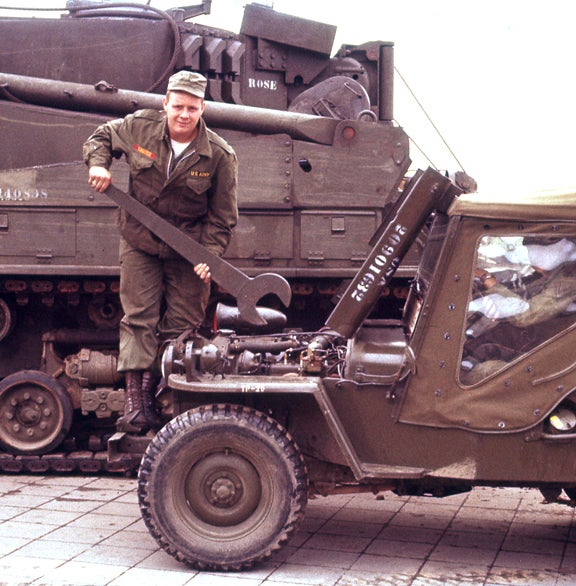
BFW: Think "Big -- Wrench."
BLACKOUT LIGHT: A shielded or filtered light mounted on military vehicles and used for night driving during blackout conditions. They are designed to be almost invisible to aircraft, and were (and are) used on virtually all WWII and post-WWII U.S. military tactical vehicles up to the present day.
BLACKOUT DRIVING LIGHT: A shielded sealed-beam light of about 4¼” diameter (U.S, version), usually mounted on the left front or driver’s side of a vehicle and used for night driving during blackout conditions. It emits a diffused beam that is hard to spot from an aircraft and which primarily illuminates vertical objects.
BLACKOUT MARKER LIGHT: Also called a “convoy light.” A small light with a clear, rectangular filtered lens, usually mounted in pairs on the front of a vehicle (though motorcycles generally have one). Their purpose is to mark the position of a vehicle in a convoy, not to furnish illumination. These lights display certain shapes at different distances. Most WWII-era blackout marker lights were self-contained units with bullet-shaped housings. Beginning with early M-series vehicles, these lights were combined with parking lights, and later with turn signal lights. (See COMPOSITE LIGHTS)
BLACKOUT TAIL LIGHT: The same concept as blackout marker lights, but mounted on the rear of vehicles and displaying a red light. Most motorcycles have only one. Blackout tail lights were usually combined with SERVICE TAIL LIGHTS in the same housings, and later into COMPOSITE LIGHTS.
BLACKOUT STOP LIGHT: A small filtered light that functions as a stop light under blackout conditions. On most WWII and early M-series vehicles, the blackout stop light was combined with the right-hand blackout tail light unit. On later M-series vehicles, the blackout stop light is a self-contained unit due to the addition or retrofit of turn signals. Current M-series vehicles have blackout stop lights in composite housings.
BOBCAT: A Willys prototype ultra-light “Jeep” built in the early 1950s but never put into production.
BODY TUB: Usually refers to the complete cab of a vehicle, such as the cab of an M37, but does not include doors, seats, windshield, or a cab top (if such a top is removable). The body tub of a Jeep usually includes the complete body assembly, less seats, accessories, windshield, front fenders, hood, and grille.
BOMB SERVICE: Usually a variant of a cargo truck fitted with a hoist and used to transport bombs on airfields and/or load bombs aboard aircraft. (See VARIANT)
BOWS: Usually refers to wooden or metal arches used to support the canvas of cargo bed covers on military vehicles. (See CANVAS)
BRADLEY: A current production family of full-tracked infantry fighting vehicles (IFV) that resemble tanks.
BUMPERETTE: Small rear bumpers used on most common wheeled U.S. military vehicles. Usually mounted in pairs and flanking the pintle. (See PINTLE)
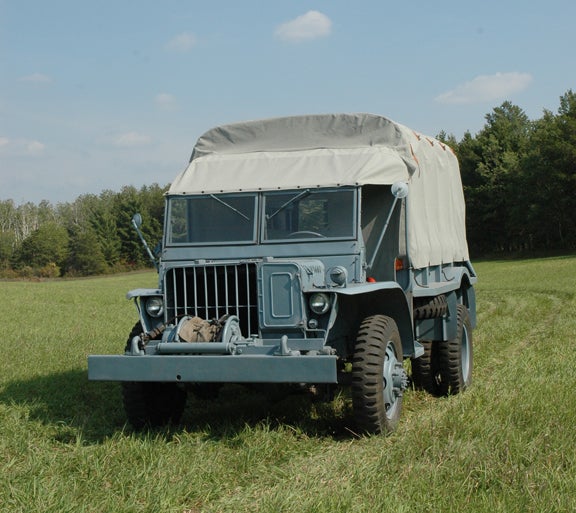
BURMA JEEP: G-number designation: G-622. Manufacturer designation: GTB. “Burma Jeep” is a nickname for two-axle, six-wheel-drive 1½-ton trucks built by the Ford Motor Company during WWII. Most are cargo trucks, though variants include a bomb service model and a wrecker. Primarily used by the U.S. Navy, though some served on the Burma Road, hence the nickname.
C
CANVAS: Usually refers to a military vehicle’s canvas or vinyl cab top and/or cargo bed cover.
CAPSTAN WINCH: A type of winch with a vertical drum, usually meant for use with rope as a self-recovery device. Capstan winches were fitted to GPAs, Weasels, and a few WWII jeeps.
CAMMO or CAMO: Usually refers to a camouflage paint scheme on military vehicles. Camouflage patterns vary greatly, from greens and browns for forest or jungle, sand and tan colors for desert operations, to white with shadows for snow or arctic conditions.
CARRYALL: Usually refers to a vehicle with a panel truck type body but having rear side windows (versus a true panel truck that does not have rear side windows). Carryalls can transport cargo or be fitted with rear seats to transport personnel, hence the name. Some carryalls are equipped as radio vehicles for Signal Corps use.
CASH: Small, rectangular pieces of paper which are generally what sellers of HMVs are referring to if they state “cash only” in their ads.
CCKW: G-number designation: G-508. Manufacturer designation: CCKW. A three-axle, ten-wheel-drive 2½-ton truck built by General Motors Corporation during WWII. Most are powered by a GMC 270 cid, 6-cyl OHV engine, have five-speed overdrive transmissions and two-speed transfer cases. Most are cargo trucks, though there are also many variants. A common WWII nickname was “Jimmy.”
CENTRAL TIRE INFLATION SYSTEM (CTIS): A system incorporating an on-board air compressor, air lines and controls to inflate or deflate a vehicle’s tires for better traction or flotation depending upon terrain and load. This system was first used on DUKWs in WWII and is also used on many of today’s HMMWVs.
CERLIST: Usually refers to a 3-cylinder, 75 horsepower, 2-cycle diesel engine sometimes fitted to Willys/Kaiser FC military trucks. (See FORWARD CONTROL)
CID: Cubic Inch Displacement. Often used to describe or rate the size or model of older engines, such as the GMC 270 or Chevrolet 235. Today’s engines are usually rated or described in liters.
CJ2: The first civilian Jeep built by Willys Motors in 1946. It closely resembled the WWII Willys MB. CJ stood for “Civilian Jeep.”
CJ3A: An improved CJ2 of late 1940s production.
CJ3B: An improved CJ3A, usually fitted with an F-HEAD engine. (See also F-HEAD and HURRICANE). Nickname: “Tall hood Jeep.”
CJ4: Although the CJ4 designation was never used for a Jeep built in the U.S. it was a model designation for Jeeps built under Willys license by Mahindra Jeep of India and Mitsubishi Jeep of Japan.
CJ5: A civilian Jeep first built by Willys Motors in 1955, then Kaiser Jeep, American Motors, and Daimler-Chrysler. Originally based on the M38A1.
CLARY FLANGE: See FREE-WHEELING FLANGE.
CLOSED CAB: Usually refers to a vehicle with a fully-enclosed and non-removable cab, such as the cabs of most civilian trucks. Many early production WWII trucks, such as the GMC CCKW, were manufactured in both closed and open cab models. However, later in the war, many closed cab vehicles were discontinued. One reason was to conserve metal. Another was to give drivers better overhead vision in order to spot attacking aircraft.
CMP: Canadian Military Pattern. Usually refers to WWII Canadian military tactical vehicles.
COE: Usually refers to “Cab-Over-Engine” vehicles, such as the GMC AFKWX and the Willys M677.
COLD WAR ERA: In the HMV hobby, usually refers to the 1950s up to the mid-1960s, even though the Cold War lasted much longer.
COMBAT RIM or COMBAT WHEEL: See BATTLE RIM.
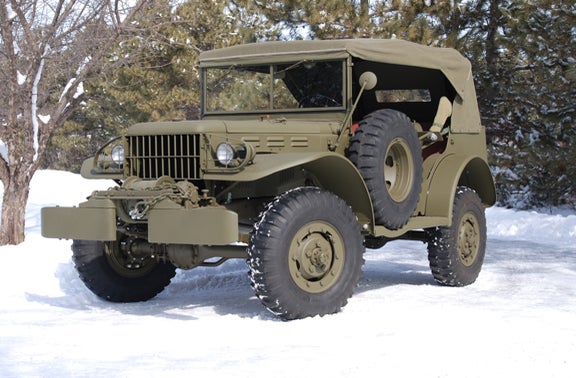
COMMAND CAR: G-number designations G-505, G-502 and G-741. M-series designation: M42. Manufacturer designation: WC (WWII models). Two-axle, four-wheel-drive vehicles built by the Dodge division of Chrysler Corporation before, during, and after WWII. The G-505 is a family of ½-ton vehicles, while the G-502 is a family of ¾-ton vehicles. The G-741 is a family of M-series vehicles, of which the M37 cargo truck is the most common. The WWII command cars were much more specialized than post-WWII models, having distinctive open bodies and canvas tops reminiscent of 1920s touring cars. This proved to be a liability because the enemy made them priority targets. Consequently, the post-WWII M42 Command Car was basically an M37 3/4-ton cargo truck equipped with a special canvas shelter and interior equipment, but outwardly looked like a cargo truck.
COMPOSITE LIGHTS: Military vehicle lamp units that usually combine parking, blackout marker, and turn signals on the front of a vehicle, and service tail/stop/turn signal, blackout marker, and blackout stop lights on the rear. Early M-series composite lights have cast aluminum housings, while later and current models are plastic. All such units are waterproof.
CONTACT MAINTENANCE: Usually refers to a vehicle equipped to service and repair other vehicles in frontline combat areas.
CONTINENTAL: Usually refers to the Continental Motors Company, a U.S. manufacturer of engines for automobiles, tractors, trucks, military vehicles and stationary equipment from 1900 through the 1960s. Continental also manufactured MULTIFUEL engines for the U.S. Military. (See also MULTIFUEL)
CONVOY LIGHT: Nickname for blackout marker lights.
CORRECT: Usually refers to parts, components or vehicle accessories that are “correct” for a specific vehicle of a specific era. However, when used in advertisements, “correct” may be only a seller’s claim or opinion.
CRASH BOX: Slang term for a non-syncromesh -- usually spur gear -- manual transmission, such as the four-speed transmission used in the Chevrolet G-506.
CRASH TRUCK: Usually refers to a fire-fighting/rescue vehicle equipped to respond to airplane crashes or fires on airfields.
CTIS: Acronym for CENTRAL TIRE INFLATION SYSTEM.
CUCV: Acronym for “Commercial Utility and Cargo Vehicle.” A family of four-wheel-drive tactical vehicles in the ¾- to 1¼-ton range, based on civilian trucks such as the Chevrolet, GMC, and Dodge pickups of the 1970s to present-day. These vehicles are slightly or partly militarized civilian trucks generally not intended for frontline combat duty.
D
DAILY-DRIVER: Usually refers to a vehicle driven regularly for work and/or recreation.
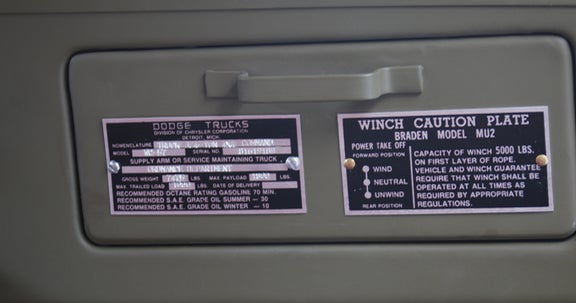
DATA PLATE or DATA PLATES: Usually refers to brass or aluminum plaques usually riveted to the dashboards or glove box (MAP COMPARTMENT) doors of most U.S. MVs from pre- WWII to the present-day. Such plates usually identify and denote the specific vehicle type and/or VARIANT, and usually include a vehicle’s individual serial or “VIN” number (which is often used for civilian registration). Data Plates may also specify a vehicle’s date of manufacture (though this may instead be the date it was accepted into military service). Data Plates may also show the net and gross weights and shipping dimensions of a vehicle, including “reducible dimensions,” as well as indicate additional factory-installed equipment, such as a winch. Other Data Plates may provide information about operating the vehicle and its equipment, maximum allowable road speeds, and basic service and maintenance instructions, as well as the Technical Manuals (TMs) applying to the vehicle. Buyers of HMVs, especially older vehicles, should be aware that Data Plates are easily switched from one vehicle to another. (The Data Plates of some vintage HMVs are attached with ordinary screws; and in the case of M37s, it’s simply a matter of switching glove box doors. While this is often done for legitimate reasons -- such as when an MV dealer has a title to a BASKET CASE but no title for a running vehicle of the same type (presumably acquired through honest means) -- it is still something a buyer should ask about. Some indications that Data Plates may have been switched are “Pop-Rivets” or fasteners of a different type on a vehicle’s VIN plate versus any other plates. Also plates that indicate a different body type or additional equipment than this particular vehicle has or doesn’t have. (Though the older the vehicle, the more likely it is to have been modified and equipment installed or removed.) Generally-speaking, it’s best to trust one’s instincts: if it doesn’t feel right, it probably isn’t.
DEEP-WATER FORDING KIT: A military-issued accessory kit for many M-series vehicles, usually consisting of snorkels for the engine air intake and exhaust pipe, allowing a vehicle to be driven under water, generally to the depth of the driver’s chest.
DEUCE or DEUCE-AND-A-HALF: Nicknames for three-axle, ten-wheel-drive and/or six-wheel-drive cargo trucks of any manufacturer. It is generally accepted that these nicknames came into use after WWII, probably during the Korean and Cold War eras.
DODGE: A division of Chrysler Corporation, currently Diamler-Chrysler Corporation.
DOGHOUSE: Usually refers to the front body parts of a vehicle, such as the hood, grille, and front fenders that house the engine.
DRIVE-ANYWHERE: A generally meaningless term often used in advertisements. It is only a seller’s claim or opinion.
DUKW: G-number designation: G-501. Manufacturer designation: DUKW. Nickname: “Duck.” Three-axle, six-wheel-drive, 2½-ton amphibious cargo trucks built by General Motors Corporation during WWII. These vehicles are based on the CCKW chassis and use most of the same mechanical components.
E
EASY RESTORATION: A generally meaningless term often used in advertisements. It is simply a seller’s claim or opinion; and what may seem “easy” to one person may seem a MAJOR DISASTER to another.
ENGINE HEATER: A military-issued, often fuel-fired (gasoline or diesel) heater fitted to M-series vehicles for extreme cold weather operation and used to heat the engine coolant to keep it from freezing. Often part of an ARCTIC KIT.
F
F-HEAD: A type of engine design in which the exhaust valves are mounted in the block while the intake valves are mounted in the cylinder head. An example is the Willys Hurricane engine used in the M606 and M38A1 Jeeps.
FAV: Fast-Attack Vehicle. Usually a light four-wheel-drive vehicle (though can also be two-wheel-drive) either specially built or modified from an existing vehicle for high-mobility and speed in frontline combat areas. FAVs are usually armed with machine guns or missile launchers.
FC: See FORWARD CONTROL.
FC 150: See FORWARD CONTROL.
FC 170: See FORWARD CONTROL.
FIELD REPAIR: Usually refers to vehicle repairs made in the “field,” by the side of the road, or during combat conditions. Often a simple quick-fix or temporary repair.
FIELD MODIFICATION: Usually refers to something added to a vehicle or modified in the “field” — such as a WIRE CUTTER on a Jeep — versus a modification performed at the vehicle’s factory. Such modifications may or may not be officially authorized by the military. GUN TRUCKS of the Vietnam War were field modifications, while adding armor to an HMMWV is a common field modification performed today. Also a slang term for civilian modifications to a military vehicle... and such modifications may make a vehicle less desirable to HMV buyers and collectors.
FIVE-QUARTER: Nickname for the M715 1 1/4-ton truck.
FLATHEAD: Also L-HEAD and T-HEAD. A type of engine design in which the intake and exhaust valves are mounted in the engine block, and the cylinder head is “flat” with no mechanical components. Common examples are the Dodge M37 engine and the Willys “Go-Devil” engine.
FLAT FENDER JEEP: Nickname for early model Jeeps such as the Willys MB and M38. Also applied to civilian Jeeps such as the CJ2 and CJ3A.
FLAT TOW: Usually one vehicle towing another vehicle with a TOW BAR versus the towed vehicle’s front end being lifted as with a tow-truck.
FMC: Food Machinery Corporation. Despite the prosaic name, FMC has many diverse divisions, including the manufacture of military vehicles.
FORD: Ford Motor Company.
FORDING: Usually refers to driving a vehicle through a river or stream.
FORDING CONTROL: Usually refers to a handle or knob on a military vehicle’s dashboard that controls a valve on the engine. When engaged, it pressurizes the engine’s crankcase, and sometimes other components such as the transmission and transfer case, to keep water out when fording. Many M-series vehicles have fording controls whether or not they are equipped with a fording kit.
FORDING KIT: See DEEP WATER FORDING KIT.

FOWARD CONTROL: A series of four-wheel-drive, cab-over-engine vehicles in the 1/4 to 1 1/2-ton range manufactured by Willys Motors and Kaiser Jeep from 1956 to 1965. The FC 150 1/4-ton model used the Willys HURRICANE 134 CID 4-cylinder F-head engine, while the 3/4 FC 170 and 1 1/2- ton models used the Willys SUPER HURRICANE 226 CID 6-cylinder L-head engine (though an optional V-8 engine was offered in late-production trucks.) Four 3/4-ton models were built for the U.S. Military: M676, M677, M678 and M679. Some military models are powered by a 3-cylinder CERLIST diesel engine.
FRAME-OFF RESTORATION: Usually refers to restoring a vehicle by removing the body componets from the frame or chassis. However, when used in advertisements, the term is no guarantee that the restoration was done well or correctly.
FREE-WHEELING FLANGE: Nickname for a vehicle’s front drive flange that has usually had its splines bored or drilled out so it disconnects the front axle from the front wheels for highway driving. Such flanges are often made in home workshops, though a factory-made CLARY FLANGE was once offered for early model Jeeps.
FRONT-END SHIMMY: A condition in which a vehicle’s front wheels shimmy side-to-side, sometimes to the point where the vehicle becomes uncontollable or suffers damage. Shimmy may be caused by bent wheels, tires out of balance, and/or wear on front axle components.
FRONTLINE: Usually refers to the “front” or main combat area during wartime. Most tactical military vehicles are designed for frontline operation.
FUBAR: “F***** Up Beyond All Redemption.”
FULL-TRACKED: Any fully-tracked vehicle, such as a tank or a bulldozer.
FULL RESTORATION or FULLY RESTORED: While this should refer to a vehicle that has been completely restored to original factory specifications, it is often just an ambiguous term used in advertisements. As such, it does not guarantee a show-quality restoration or even that a restoration was done correctly or well, and may be only a seller’s claim or opinion.
G
G-NUMBER: A system of designations used by the U.S. Army, combining groups of vehicles that may have many variants but are basically similar in regard to engines, transmissions, axles, chassis, and mechanical components. G-numbers are not generally used in the HMV hobby for post-WWII and present-day vehicles. There are far too many G-numbers to be included in this basic Glossary, so only those of vehicles common in the HMV hobby are listed here.
G-506: A two-axle, six-wheel-drive 1½-ton truck built by the Chevrolet division of General Motors Corporation during WWII. Most are powered by a Chevrolet 235 cid, 6-cyl OHV engine, have four-speed spur-gear transmissions and two-speed transfer cases. Most are cargo trucks, though several variants include a Signal Corps van and a Bomb Service model.
G-518: A 1-ton two-wheeled cargo trailer of WWII, manufactured by Ben-Hur, Checker, and Springfield Auto Works (though commonly called a “Ben-Hur” in the HMV hobby). Tire size is usually 7.50 X 20. Although intended to be pulled by 1 1/2 and 2 1/2 -ton trucks of the period, such as the Chevrolet G-506 and the GMC CCKW, these trailers are “correct” for almost any WWII MV capable of pulling them. A few were still in service -- though mainly “on base” -- into the 1960s. Variants include water and fuel tankers.
G-529: A 1/4-ton two-wheeled cargo trailer specifically designed for WWII jeeps and manufactured by many companies, including Bantam, Checker, Converto, Crosley and Fruehauf in addition to Willys Motors. These trailers use the same wheels and tires as the MB and GPW, have no tailgate and are amphibious (though tailgates were often added by civilian owners). The lighting system was usually 6-volt. Probably the most desirable large accessory for WWII jeeps.
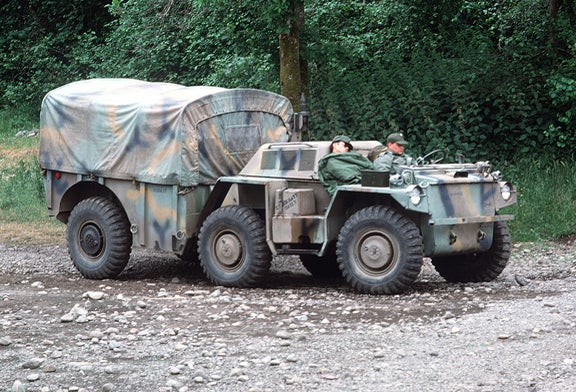
GAMA GOAT: G-number designation: G-847. M-series designation: M561 (basic cargo model). A three-axle, six-wheel-drive, 1½-ton cargo/troop-carrying vehicle. The Gama Goat is an unusual vehicle, having a permanently-attached trailer and front and rear steering. Although touted as being amphibious, its actual swimming capabilities are very limited. The “Gama” name came from the designer of the vehicle’s articulation/power transfer joint (between the four-wheeled tractor unit and the two-wheeled trailer), Roger L. Gamaunt. The Gama Goat is powered by a Detroit Diesel 3-53 engine. Variants include an ambulance.
GI: Nickname for U.S. soldiers. Derived from “Government Issue.”
GMC: General Motors Corporation.
GO-DEVIL: Willys Motors name for the four-cylinder, 134 cid, L-head engine first used in Willys automobiles of the 1930s, then in WWII Jeeps, as well as the Korean War era M38. This engine was also used to power generators and welding machines, among many other industrial and marine applications.
GOOD-RUNNER: A generally meaningless term often used in advertisements. It is only a seller’s claim or opinion.
GP: A prototype “Jeep” built by the Ford Motor Company. (Also one of the most probable explanations of how the Jeep got its name.) GPs are rare vehicles today.
GPW: G-number designation: G-503. Manufacturer designation: GPW. Nickname: “Jeep.” Although the Ford prototype “GP” was not chosen for production by the U.S. Military, Ford was awarded a contract to build Willys Jeeps during WWII. With a few minor differences, the Ford GPW (presumably standing for Ford’s “GP” being built to the Willys design) was a clone of the Willys production model MB.
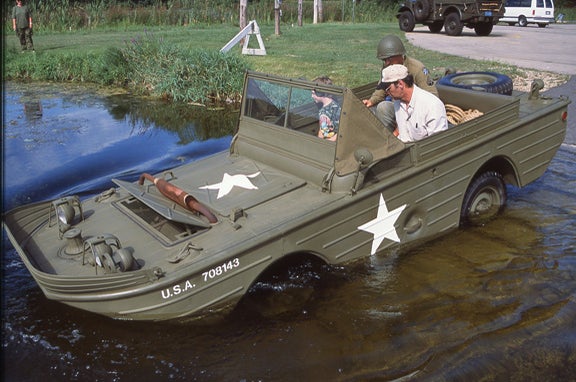
GPA: G-number designation: G-504. Manufacturer designation: GPA. The GPA is a Ford-built two-axle, four-wheel-drive amphibious vehicle based on the GPW. Although a remarkable vehicle, the GPA proved to be limited in combat roles. One nickname was “Seep,” which could have meant either “Sea-going Jeep,” or possibly referred to its marginal seaworthiness. A highly modified GPA was sailed and driven around the world in the 1950s. GPAs are very rare and valuable today.
GUN TRUCK: Usually refers to 2 1/2 and 5- ton cargo trucks in the Vietnam War that were armor-plated and armed in the field (see also FIELD MODIFICATION) to escort convoys.
H
HMV: Historic Military Vehicle
HALF-TRACK: G-number: G-102, G-147. Basically an armored truck with rubber tracks instead of rear wheels. Half-tracks were intended for troop transport and as fighting vehicles. The G-102 was built by the White, Diamond-T, and Autocar truck companies during WWII. The G-147 was built by International Harvester Corporation (IHC) during WWII. There are many variants. Half-tracks were phased out of U.S. military service after WWII, but were still in use by other armed forces well into the 1970s.
HARD CAB: Usually refers to a vehicle’s metal, wooden, or fiberglass cab top or enclosure when such a top is removable, versus a CLOSED CAB, which is an intagral part of a vehicle.
HEAVY HMMWV: See HMMWV.
HERCULES: Usually refers to the Hercules Engine Company, founded in 1915 and a U.S. manufacturer of engines for automobiles, tractors, trucks, military vehicles and stationary equipment. Hercules also manufactured MULTIFUEL engines for the U.S. Military. (See also MULTIFUEL)
HOTCHKISS: A French manufacturer of Jeeps and Jeep parts under Jeep license.
HMMWV: M-series designation: M998 (basic model). Nickname: “Humvee” (“Hummer” is generally a civilian term.) A two-axle, four-wheel-drive 1¼-ton cargo/utility vehicle built by AM General and in current use by the U.S. Military. A “Heavy HMMVW” is rated at 1 1/2- ton capacity. There are many variants of the HMMWV. The name is derived from “High-Mobility, Multipurpose Wheeled Vehicle.”
HURRICANE: Willys/Kaiser name for the 4-cylinder. 134 cid, F-head gasoline engine used in CJ3B, CJ4, CJ5, FC 150, M606 and M38A1 Jeeps.
I
IDIOT LIGHTS: Slang term for dashboard warning lights used to replace actual instruments — most commonly ammeters and oil pressure gauges — on various vehicles, including many American cars and light trucks of the late 1950s into the late 1970s. A few U.S. MVs, such as the M422 MIGHTY MITE, had such lights.
IHC: International Harvester Company. Slang terms for IHC vehicles include “Corn-Binder” or simply “Binder.”
J
JEEP: While the name, “Jeep,” is often applied by the general public to any small four-wheel-drive vehicle or present-day SUV (Sport/Utility Vehicle), it is properly used in the HMV hobby to denote ¼-ton, four-wheel-drive vehicles such as the GPW, MB, M38, M606, and M38A1, built by Willys Motors (also Ford during WW II) and Kaiser Jeep Corporation during the Korean War and Cold War eras. Also, civilian Jeep models, such as the CJ2, CJ3A, CJ3B, CJ4 and CJ5. While there are many theories as to the origin of the name, it seems most likely derived from the original Ford factory designation, “GP” (which did not stand for “general purpose”). There is an ongoing debate in the HMV world as to whether the M151 MUTT should also be called a “Jeep,” though it was so called by many GIs.
JERRY CAN: Nickname for the 5-gallon spare fuel container mounted on most U.S. military vehicles. The nickname came from the German fuel containers of WWII, which were of similar design and superior to most pre-war U.S. fuel containers, and were therefore copied. WWII and early post war models usually have caps with rolled tabs, while most later and present-day models have straight tabs. The caps are intentionally the same size and thread pattern as most common 55-gallon fuel and oil drums. Civilian reproductions (see also REPRO) are often made of lighter gauge metal and are sometimes poorly manufactured and prone to leakage.
JIMMY: Nickname for WWII 2½- ton trucks built by GMC.
K
KAISER: Usually refers to the Kaiser Jeep Corporation.
KOREAN WAR ERA: In the HMV hobby, usually refers to the early 1950s.
L
L-HEAD: Also FLATHEAD. Usually refers to a type of engine design with intake and exhaust valves in the block and mounted to one side of the cylinders so the combustion chamber is an inverted “L.” Examples are the Willys four-cylinder Go-Devil engine and the six-cylinder Dodge engines used in the WWII WC trucks and the post-WWII Dodge M37.
LANDING LEG or LANDING GEAR: Common terms for a skid or wheel mounted on the front of trailers and lowered to keep the trailer level when disconnected from the towing vehicle.
LIFTING SHACKLE: Metal rings or loops usually mounted on a military vehicle’s front and rear bumpers or frame and used for lifting the vehicle, such as when loading vehicles aboard a ship.
LOCKOUT HUBS or LOCKING HUBS: Also called “free-wheeling hubs.” These are usually aftermarket items available for most civilian all-wheel-drive and many common HMVs. They disconnect the front wheels from the front axle shafts for highway use. Advantages are less wear on the front drive train, better fuel mileage, and less tendency for front-end shimmy.
LUNETTE: Usually refers to the ring type hitch of most U.S. military trailers and TOW BARS.
M
M-SERIES: A designation system used by the U.S. military to denote a make, model, and type of vehicle. Unlike the Army G-number, which generally refers to a group or family of vehicles, the M-series number usually specifies the type of vehicle and its variant, including special equipment or armament. An example is the M37 cargo truck, which has an ambulance variant designated M43, and a command car variant designated M42, among many others. In the HMV hobby, M-series designations are generally used for post-WWII era vehicles up to the present-day. Most M-series vehicles have standardized 24-volt waterproof electrical and ignition systems and share many minor components such as blackout and taillights, as well as dashboard instruments. There are far too many M designations to be included in this basic Glossary, so only those of vehicles common in the HMV hobby are listed here.
M-SERIES LIGHT SWITCH: A standardized switch used in virtually all M-series vehicles. It controls the SERVICE DRIVING LIGHTS as well as the BLACKOUT LIGHTS. A lockout prevents the service driving lights from being switched on accidentally. The switch also allows the SERVICE STOP LIGHT(s) to be turned off.
M-1-4: The “M” is misleading on vehicles designed and built by the International Harvester Company (IHC) during WWII because it was a factory designation rather than an M-series number. Presumably, the “M” stood for military vehicle, or a vehicle built for the military. The M-1-4 is a ½-ton, two-axle, four-wheel-drive cargo truck built for the U.S. Marine Corps. There are several variants, including an ambulance. I.H.C. WWII vehicles are rare today.
M-2-4: A 1-ton, two-axle, four-wheel-drive cargo truck built by IHC for the U.S. Marine Corps during WWII. Variants include an ambulance.
M-3-4: A 1½-ton, two-axle, six-wheel-drive cargo truck built by IHC during WWII. There are several variants, including a CRASH TRUCK and an AIRFIELD LIGHTING VEHICLE.
M-3-6: A 1½-ton, three-axle, six-wheel-drive cargo truck built by IHC during WWII. A very rare vehicle today.
M-5-6: A 2½-ton, three-axle, ten-wheel-drive cargo truck built by IHC for the U.S. Marine Corps during WWII. Several variants include a tanker and dump truck.
M29: See WEASEL.
M34: A six-wheeled variant of the M35.
M35: G-number: G-742. A Korean War and Cold War era 2½-ton, three-axle, ten-wheel-drive cargo truck, originally designed and built by the REO Motor Truck Company. Early nicknames were “Eager Beaver” (which did not stick) or simply “Reo.” These trucks are commonly called “deuce-and-a-halfs” or “deuces.” There are many variants, and these trucks were built by many different companies, such as Willys/Kaiser Jeep, Studebaker, American Motors, and AM General. As a series, these trucks are still in service today.
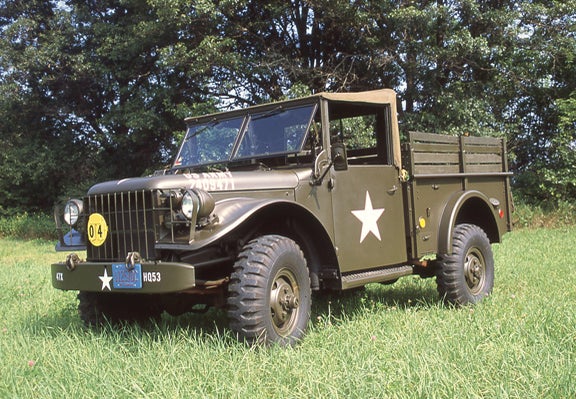
M37: G-number: G-741. A two-axle, four-wheel-drive, ¾-ton cargo truck built by the Dodge division of Chrysler Corporation, beginning in the early 1950s. Although phased out of U.S. military service in the early 1970s, many M37s are still in service with other armed forces. Probably the most popular U.S. HMV next to the Jeep.
M38: G-number: G-740. Willys factory designation: MC. A Korean War era Jeep built by Willys Motors and based on the civilian CJ3A.
M38A1: G-number: G-758. Willys factory designation: MD. A Korean War era Jeep built by Willys Motors. Also called a “round-fender Jeep.” This Jeep’s doghouse was redesigned to accommodate the new Willys F-head engine. The CJ5 was a civilian version of the M38A1. (While the M38A1 went into production in 1952, the CJ5 did not appear until 1955.)
M54: G-number: G-744. A Cold War and Vietnam era 5-ton, three-axle, ten-wheel-drive cargo truck, originally designed and built by IHC beginning in 1953, and later also built by Mack Trucks. These vehicles had the same cab as the Reo 2 1/2- ton trucks. Early models were powered by a Continental 602 cid gasoline engine, while most Vietnam era models used MULTIFUEL engines. In Vietnam, these trucks became the vehicle-of-choice to be modified as GUN TRUCKs. Many variants.
M76: See OTTER.
M100: G-number: G-747. A 1/4-ton, two-wheeled, post-WWII cargo trailer designed for the M38 and M38A1 jeeps. M100s are very similar to WWII G-529s, having no tailgates, being amphibious, and using the same tires and wheels as their primary towing vehicles. The most readily apparent differences are grab handles on all four corners and an M-series 24-volt lighting system. Since, during the Korean War, many MBs and GPWs were still in service, it could be said that M100 trailers are “correct” for WWII jeeps restored for that time-period. Inversely, since many G-529s were still in service, it could be argued that they are “correct” for M38s and M38A1s in that context.
M101: G-number: G-748. A 3/4-ton two-wheeled cargo trailer designed for the M37, using the same wheels and tires, and having a 24-volt lighting system. Probably the most desirable large accessory for an M37. These trailers were also pulled by the Kaiser M715, various CUCVs, and also HMMWVs. Variants include water and fuel tankers.
M104: G-number: G-754. A 1 1/2-ton two-wheeled cargo trailer designed for M-series 2 1/2 ton trucks, though “correct” for almost any M-series vehicle capable of pulling them. Many variants, including different size tires.
M113: A full-tracked, amphibious APC designed in 1959, built by FMC, and used extensively during the Vietnam War. Often called a “One-One-Three.” A common Vietnamese nickname was “Green Dragon.”
M135: A six-wheeled variant of the M211.
M211: G-number: G-749. A three-axle, ten-wheel-drive, 2½-ton cargo truck designed and built by General Motors in the early 1950s. GMC hoped that this truck would replace their famous CCKW of WWII, but it was phased out in favor of the M35 and was usually only in “stateside” service by the late 1960s. The M211 has a 302 cid, 6-cyl, OHV, GMC gasoline engine and a four-speed Hydra-Matic transmission.
M274: See MULE.
M416: G-number: G-857. A 1/4-ton, two-wheeled cargo trailer designed for the M151 MUTT. Similar to the G-529 and M100, having no tailgate and being amphibious, the most readily-apparent differences are angled instead of rounded fenders and the same wheels and tires as the MUTT. These trailers were also towed by M38s, M606s and M38A1s still in service.
M606: A partly militarized CJ3B built by Willys Motors during the 1950s and 1960s. Also built by Mahindra Jeep of India and Mitsubishi of Japan. Often called a “tall hood Jeep” because its hood, grille and cowl are taller than other “flat fender” Jeeps to accommodate the F-head engine. Most served in the U.S. Navy, though many were used by the Army in Vietnam. Rarest of U.S. military Jeeps, except for the WWII prototypes.
M676: A 3/4-ton, four-wheel-drive, COE cargo truck based on the Willys/Kaiser FC 170. Its 2-door cab seats 2 persons. Powered by either a Willys 226 cid 6-cylinder L-head gasoline engine or a CERLIST 3-cylinder diesel engine. (See also FORWARD CONTROL)
M677: A 3/4-ton, four-wheel-drive, COE cargo truck based on the Willys/Kaiser FC 170. Its 4-door cab seats four persons. Powered by either a Willys 226 cid 6-cylinder L-head gasoline engine or a CERLIST 3-cylinder diesel engine. (See also FORWARD CONTROL)
M678: A 3/4-ton, four-wheel-drive, COE CARRYALL based on the Willys/Kaiser FC 170. Powered by either a Willys 226 cid 6-cylinder L-head gasoline engine or a CERLIST 3-cylinder diesel engine. (See also FORWARD CONTROL)
M679: A 3/4-ton, four-wheel-drive, COE Ambulance or utility van based on the Willys/Kaiser FC 170. Powered by either a Willys 226 cid 6-cylinder L-head gasoline engine or a CERLIST 3-cylinder diesel engine. (See also FORWARD CONTROL)
M715: Nickname, “five-quarter.” A 1¼-ton, two-axle, four-wheel-drive cargo truck designed and built by Kaiser Jeep Corporation from 1967 to 1969. These trucks were built from mostly off-the-shelf civilian components, and their cabs and front sheet metal were basically from the civilian Jeep Gladiator trucks. Although rugged in many ways, the truck’s major fault was its poorly designed and troublesome Kaiser six-cylinder overhead-cam engine. (See TORNADO)
M880: A series of partially militarized 1¼-ton trucks based on Dodge civilian trucks of the 1970s.
M998: See HMMWV. MA: Willys Motors designation for the early production WWII Jeep. Only about 1,500 MAs were built, and many were sent to Russia. The MA is a rare vehicle today.
MAP COMPARTMENT: Usually a military term for a vehicle’s glove box.
MB: Willys Motors designation for the main production G-503 WWII Jeep. In the HMV hobby, “MB” is a common designation for WWII Willys Jeeps.
MC: Willys Motors designation for the M38 Korean War era Jeep. Not commonly used in the HMV hobby to describe the M38.
MD: Willys Motors designation for the M38A1 Korean and Cold War era Jeep. Not commonly used in the HMV hobby to describe the M38A1.
MAHINDRA JEEP: A Jeep manufactured by Mahindra of India. Many Mahindra Jeeps resemble the M606, though newer and current models resemble the M38A1.
MAJOR DISASTER: See GOOD-RUNNER, EASY RESTORATION, RESTORABLE, NORMAL RUST and FUBAR.
MATCHING NUMBERS or NUMBERS MATCH: Usually refers to a military vehicle that has body, frame, and engine model or serial numbers that “match” as factory-assembled. This usually indicates that the vehicle is all original in regard to its major components: that its engine has not been replaced, or its body has not been mounted on a different frame. However, matching numbers do not necessarily mean that the vehicle’s engine was never rebuilt, or that some components such as the transmission or transfer case were not replaced. Nor does it necessarily mean that the vehicle is fully or correctly restored, or factory original in regard to minor components and accessories.
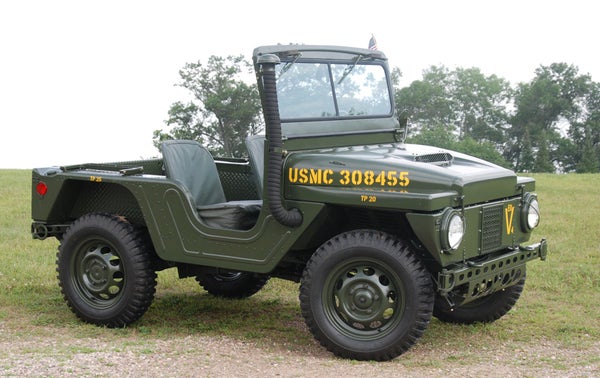
MIGHTY MITE: G-number designation: G-843. M-series designation: M422. A ¼-ton, two-axle, four-wheel-drive vehicle resembling a scaled-down M38A1 and built by American Motors. Basically an ultra-light Jeep designed to be easily air-transportable and intended to support paratroopers. It has an all-aluminum body and is powered by an air-cooled V-4 engine. A unique feature is that the vehicle may be operated in emergency situations without one of any of its four wheels.
MILITARIZED: Usually refers to a civilian vehicle that has been slightly to extensively modified for military service. Examples are the M38 Jeep, which was an extensively militarized CJ3A, or the Dodge M880 which was a partially militarized civilian truck.
MITSUBISHI JEEP: A Jeep manufactured by Mitsubishi of Japan. Most Mitsubishi Jeeps resemble the M606.
MULE: M274. A ½-ton, two-axle, four-wheel-drive platform type vehicle about half the size of a Jeep and intended for cargo transport in combat areas. Mules were also fitted with various weapons. Some Mules have four-wheel steering.
MULTIFUEL: Usually refers to a type of 6-cylinder OHV engine used in Vietnam-era M35 and M54 trucks and designated LDS. Two common models are the LDS 465 and the LDS 478. While its preferred fuel is diesel, it can also run on gasoline, jet fuel, kerosene, and other similar volatile liquids, including some types of aircraft de-icer. These engines were manufactured by CONTINENTAL, HERCULES, and WHITE. There were virtually no civilian counterparts to multifuel engines.
MUTT: G-number: G-838. M-series number (basic model): M151. A ¼-ton, two-axle, four-wheel-drive vehicle designed by the Ford Motor Company in the early 1950s to replace the Wiilys Jeep. Unlike the name, “Jeep,” which was originally a nickname, “MUTT” stands for “Military Utility Tactical Truck”…although most GIs called the MUTT a “jeep.” The MUTT features an independent suspension system which makes it prone to rollover (though some MUTT enthusiasts will deny it, despite the fact that the U.S. Military was aware of this problem by the early 1960s and issued warnings to drivers) though this fault was corrected to some degree on late models. There were many variants of the MUTT, and these vehicles are still in service with many armed forces today.
M151: There are three basic models of the MUTT… the M151, M151A1, and M151A2.
MV: Military vehicle.
MVer or HMVer: A military vehicle enthusiast, user, hobbyist, collector, restorer, fan, etc.
MVM: Military Vehicle Magazine, 700 East State St., Iola, WI 54990-0001; Web site: www.militaryvehiclesmagazine.com. Ca. 19,000 subscribers, primarily in U.S. MVPA: Military Vehicle Preservation Association, P.O. Box 520378, Independence, MO 64052; Web site: www.mvpa.org. Ca. 8,500 members world-wide.
N
ND: Non-Directional. Usually refers to U.S. military tires. Such tires are called “non-directional” because they grip just as well going forward or backward.
NDCC: Non-Directional Cross Country. An alternate tread design of ND tires, intended to perform better in soft terrain.
NORMAL RUST: While some vehicles do tend to rust in specific areas, “normal rust” is often a meaningless term used in advertisements. What may seem “normal” to one person may be a MAJOR DISASTER to another. (See also FUBAR)
NOS: New Old Stock. Usually refers to new parts, often still in their original boxes or packaging, but which may have been in storage for many years or decades.
O
OD: In the HMV hobby, usually refers to olive drab paint, but may also mean “Overdrive” or “Overdose” to other people.
OHC: “Overhead cam.” Usually refers to an OHV engine design (See OHV) in which the camshaft is mounted in the cylinder head along with the intake and exhaust valves, versus a camshaft in the engine block. Example: the Kaiser Tornado engine used in the M715. (See also M715 and TORNADO.)
OHV: Usually refers to an engine with “Overhead Valves,” meaning the intake and exhaust valves are mounted in the cylinder head, versus a “Flathead” engine in which the valves are mounted in the engine block. (See also FLATHEAD, L-HEAD and T-HEAD) Common examples of OHV engines in military vehicles are the GMC 270 and the Chevrolet 235.
OFF-THE-SHELF: Slang term for parts or components that are usually in stock (on the shelf) in most auto and truck parts stores, or parts and components that already exist and are not specially made for military vehicles. Example: the Kaiser M715 was built with many off-the-shelf parts and components.
OLDER RESTORATION: Usually refers to a vehicle that was fully or partially restored several to many years in the past. Usually the vehicle has aged in normal ways— faded paint, aging of tires, deterioration of rubber parts and canvas -- and may have been driven quite a bit.
OPEN CAB: Usually refers to vehicles that do not have permanent cab tops or doors, such as many WWII WC Dodges, versus closed cab vehicles. (See CLOSED CAB) Many early production WWII vehicles were manufactured in both open and closed cab models, but most closed cab vehicles were discontinued later during the war. Some open cab vehicles may be fitted with hard cabs. (See HARD CAB)
OTTER: M76. G-number designation: G-245. A full-tracked, aluminum-bodied amphibious vehicle about the size of an M37, designed for operation in snow or marshes.
P
PERSONNEL HEATER: A heater unit, usually part of a Arctic Kit, to heat the cab, driver and/or crew and passenger compartments of vehicles. Some are fuel-fired using gasoline or diesel, while others use engine coolant.
PINTLE: Standard U.S. military vehicle hook-type trailer hitch designed for the lunette of most U.S. military trailers and tow-bars. (See also LUNETTE)
PIONEER TOOLS: Usually refers to the shovel, axe and mattock mounted on most U.S. military vehicles.
PRIVATE PARTY: Usually refers to a private individual buyer or seller, versus a dealer or company.
PS MAGAZINE: “The preventive maintenance monthly” published by the US Army Publishing Agency, Distribution Operations Facility, 1655 Woodson Rd., St .Louis, MO 63114-6128; Web site: www.apd.army.mil.
PURIST: Sometimes used as a derogatory term for a person who cannot be satisfied with any HMV (including someone else’s) unless it has been fully restored to original factory condition. Being a “purist” is not necessarily a bad thing, but some purists give the HMV hobby a bad name by disparaging vehicles that in their opinions are less than “correct”… often within earshot of the vehicles’ owners, friends and family. Ironically, many purists have little or no hands-on experience restoring their own vehicles -- if they actually have any vehicles -- but have paid someone else to restore them.
R
RACKS: Nickname for removable wooden or metal sideboards used on military cargo trucks. Racks are often combined with TROOP SEATS and may also support or serve as mountings for the BOWS.
RAG TOP: Slang term for a vehicle’s canvas or vinyl cab top.
REO: The Reo Motor Truck Company. Also a common Korean War and Cold War-era nickname for M35 and M34 2 1/2-ton trucks.
REPRO: Usually refers to reproduction parts manufactured to the same or similar specifications as original or NOS parts. However, the quality, appearance and fit of repro parts vairies widely: some are high-quality exact replicas, while others are poor-quality and only vaguely resemble original parts.

RESTORABLE: A generally meaningless term often used in advertisements for HMVs. Most vehicles are “restorable,” as long as one has the time, money, skills and facilities to restore them.
ROLLING CHASSIS: Usually refers to a vehicle that has had its engine and/or other major mechanical components or body parts removed, but still has wheels so is towable or “rollable,” as opposed to a BASKET CASE.
ROUND-FENDER JEEP: Nickname for Jeeps such as the M38A1 and the CJ5.
RUN-FLAT: See BATTLE-RIM.
S
SCOUT CAR: G-number: G-067. A two-axle, four-wheel-drive armored vehicle built by the White Motor Truck Company during WWII. The Scout Car is unique in having full-timefour-wheel-drive.
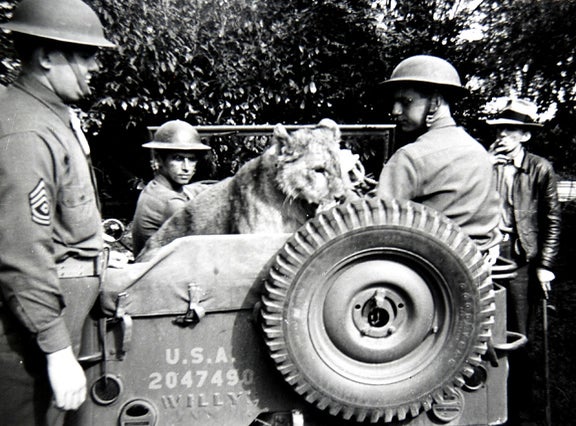
SCRIPT JEEP: Early production models of both the Willys and Ford-built Jeeps of WWII had “WILLYS” or “FORD” stamped on the left rear end of their bodies. Many other early production WWII vehicles also had company names on grilles or hoods. This practice of free advertising was discontinued by government order later in the war, and had nothing to do with the enemy discovering what company had manufactured the vehicles. ...The enemy already knew.
SELF-RECOVERY WINCH: Usually refers to the front-mounted winch on many MVs. While such winches can be used for many things, their primary purpose is to extract the vehicle from bogged-down situations.
SERVICE: While “service” can mean “to serve,” as in “serving one’s country” or “being in the service,” the term is more commonly used in the HMV hobby to describe routine maintenance performed on vehicles, such as lube jobs and oil changes, versus “Repair,” which usually means fixing or replacing something that is broken or worn out.
SERVICE DRIVING LIGHTS: A vehicle’s standard head, tail, and marker lights used during normal driving conditions.
SERVICE STOP LIGHT: A stop light that functions during normal driving conditions, versus a blackout stop light used during blackout conditions.
SERVICE TAIL LAMP: A tail light that functions during normal driving conditions, versus a blackout tail light used during blackout conditions.
SHELTER: Usually refers to a camper-like boxy unit that may be mounted in the bed of a cargo truck to shelter personnel and/or equipment.
SHIMMY: See FRONT-END SHIMMY.
SHOP VAN: Generally refers to a van-bodied vehicle equipped to do extensive service and repair of other vehicles and equipment in combat areas.
SHOW RESTORATION or SHOW-QUALITY RESTORATION: Usually refers to vehicles fully restored to original factory condition for the primary purpose of display at vehicle shows or in museums. However, in advertising, may be only a seller’s claim or opinion.
SIGNAL CORPS: Usually refers to a branch of armed forces that develops, tests, provides, and manages communications and information systems support for the command and control of combined armed forces. The U.S. Signal Corps was established in 1860.
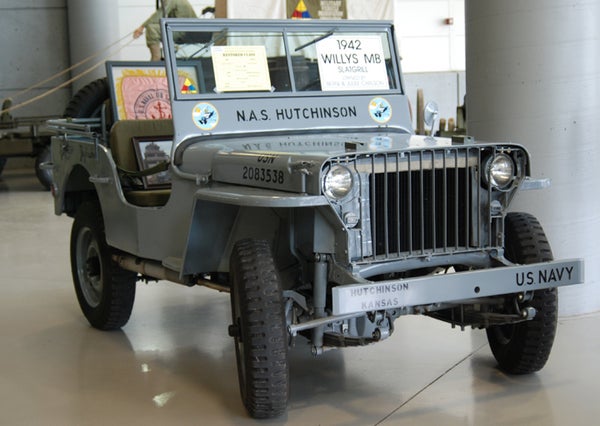
SLAT-GRILLE: Nickname that usually refers to early-production Willys Jeeps of WWII that have strap-iron grilles instead of the more common later-production stamped sheet-metal grille (which was developed by Ford). Approximately 1,500 slat-grille Jeeps were built. The demand for, and prices of, slat-grille Jeeps are not significantly higher than for the more common models with sheet-metal grilles.
SNAFU: Situation Normal, All F***** Up.
SUPER HURRICANE: Willys/Kaiser name for the 226 cid, 6-cylinder L-head gasoline engine used in many of their vehicles.
SUPER SINGLES: Usually refers to large single tires mounted on vehicles that generally used smaller dual rear wheels, such as the M211 and M35. Although the term came into use during the 1960s, the concept was far from new. Many WWII CCKWs in desert combat were fitted with 11.00 x 18 single tires to replace their 7.50 x 20 duals. This gave better performance in soft sand.
T
T24: See WEASEL.
T-HEAD: An engine design similar to an L-HEAD in which the intake and exhaust valves are located in the block. Unlike an L-head, the T-head valves are placed one on each side of the cylinder instead of on the same side, creating a “T” shaped combustion chamber.
TACTICAL VEHICLE: A vehicle intended for use in combat, such as a Jeep or a tank.
TM: Technical Manual. There are usually several TMs for most MVs, providing information about operating, servicing and repairing a vehicle. If a type of vehicle, such as a Jeep, MUTT, or M35, has been in service for many years, there are usually many updates to their TMs.
TORNADO: The Kaiser Jeep name for the six-cylinder overhead cam (OHC) engine used in M715 trucks. This engine was originally designed for civilian Jeep vehicles of the early to mid-1960s, but proved to be problematic. Ironically, the M715 went into production in 1967, years after the Tornado was no longer offered in civilian vehicles. The Tornado was the only Kaiser-designed engine to ever be used in a Jeep vehicle.
TOW BAR: Usually an accessory item that attaches to a vehicle’s front bumper, axle or LIFTING SHACKLES, allowing it to be FLAT TOWED by another vehicle.
TROOP SEATS: Usually refers to wooden or metal benches in the cargo bed of a military truck used for seating soldiers during transport in combat areas. Such seats are often part of the RACKS and may be folded out of the way when the vehicle is used to transport cargo.
TURN KEY: Usually refers to a vehicle that is in good condition and ready to drive. However, it may be only a seller’s claim or opinion.
U
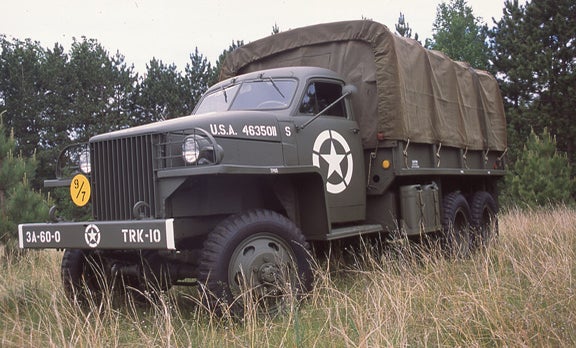
US-6: G-number: G-630. A 2-1/2-ton, three-axle, ten-wheel-drive cargo truck built by the Studebaker Corporation during WWII. Most were sent to Russia, though many also served in Alaska, probably because most had CLOSED CABS. There were several variants, including 6×4 models.
USER MVer or HMVer: Someone who drives and uses their HMV for work or play, versus someone who only drives his or her HMV in parades, or displays it.
V
VARIANT: Usually refers to a model or type of vehicle that differs in some way from the main or most common production model. Examples: The M170 ambulance is a variant of the M38A1 Jeep, while the M43 ambulance is a variant of the M37 cargo truck.
VIETNAM ERA: Usually refers to the mid 1960s to the early 1970s.
VIN: Usually means Vehicle Identification Number.
W
WC: A Dodge factory designation. In the HMV hobby it usually refers to the 1/2-, 3/4-, and 1-1/2-ton Dodge trucks of WWII. WC does not stand for “Weapons Carrier,” though is probably the origin of the nickname.
WEAPONS CARRIER: Originally a GI nickname (see WC) of WWII. It was carried over into the Korean and Vietnam War eras and was often applied to the M37. However, there was never a vehicle officially designated “Weapons Carrier” by the military.
WEASEL: M29, T24. G-numbers: G-154 & G-179. A light, Jeep-sized, full-tracked vehicle built by the Studebaker Corporation during WWII. Originally designed for use in snow, the Weasel could also be fitted with a flotation kit to make it amphibious.
WHEEL: Usually refers to a vehicle’s wheel and tire assembly. What can be confusing is when a two-axle truck equipped with dual rear wheels — hence having six-wheels — is still called a “four-by-four.” Likewise, a ten-wheeled truck with three driving axles is commonly called a “six-by-six,” even though it technically has “ten-wheel-drive.”
WHITE: Usually refers to the White Motor Company, a U.S. automobile and truck manufacturer from 1900 until 1980.
WILLYS: Willys Overland Motors Company, Willys Motors, or Willys Jeep.
WIRE CUTTER: Usually refers to a vertical pipe or angle-iron mounted on a vehicle’s front bumper and meant to cut wires strung across roads with the intent of decapitating the drivers of vehicles, such as Jeeps, being driven with their windshields down. Usually a FIELD MODIFICATION.
WRECKER: Usually refers to vehicles equipped to tow other vehicles in breakdown situations.
WWII: World War Two.
X
XM: U.S. Military designation for an “Experimental” vehicle usually still in the prototype or development stage and not yet accepted or standardized, such as an XM211.
*As an Amazon Associate, Military Trader / Military Vehicles earns from qualifying purchases.
